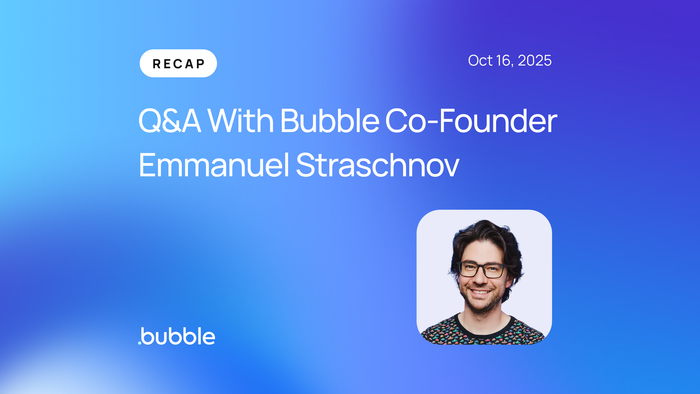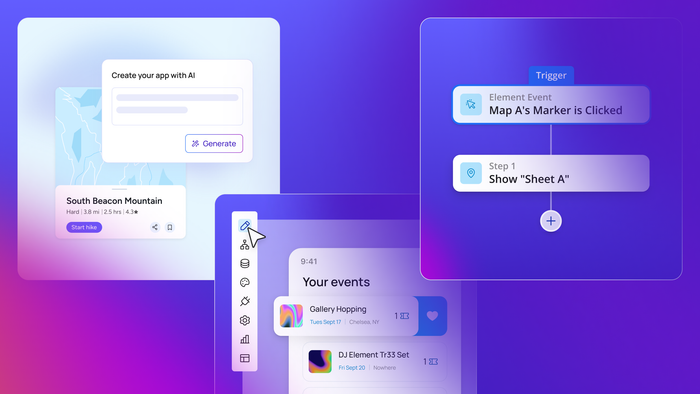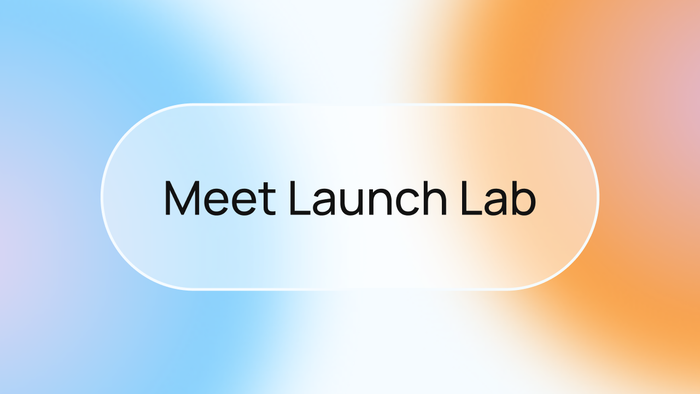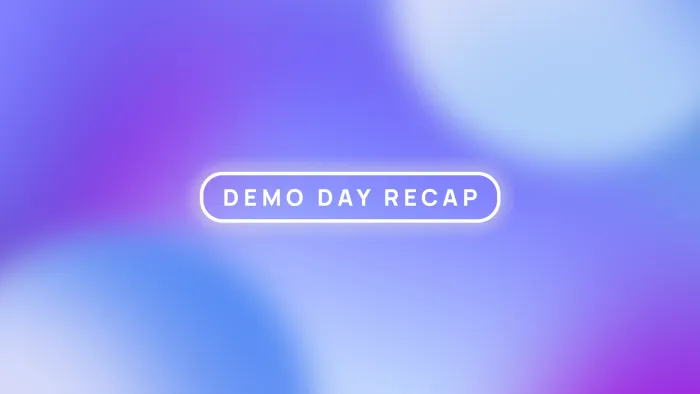Last week, Emmanuel participated in two Ask Me Anything sessions — first at Bubble Tour London following our AI Agent announcement, then in a livestreamed YouTube Q&A five days later. The combination of these conversations reflects where we are as a company: excited about what we’re building and committed to staying in close dialogue with you, our users, about our direction.
If you’re looking for full details on the AI Agent launch and other product announcements from Bubble Tour London, check out our full keynote recap. Below you can watch both AMAs or read a summary of Emmanuel’s responses — about the new releases, platform challenges, and where Bubble is headed.
Questions about the AI Agent and recent launches
What do you see as AI’s role at Bubble?
During the London Q&A, Emmanuel talked about how AI fits into Bubble’s approach: “The [combination] can be pretty magical because the AI that we’re building is going to be interpreting the different patterns in your application, and can understand the intent of what your application does.”
One core principle he shared: AI shouldn’t make changes silently. “The AI’s job will not be to make the changes without telling you, but to explain to you, ‘Hey, these are the changes that we think you should make. Do you agree with them?’”
This approach makes applications safer, but it also “teaches users how to use Bubble better,” Emmanuel said. “It’s going to make the learning curve more fun and interactive.”
How will the AI Agent work with existing apps, not just AI-generated ones?
Right now, the Agent is limited to AI-generated apps. As Emmanuel explained, “It’s a way for us to control which applications have access to ensure that we have a gradual launch.” The main challenge is that the Agent needs context of your entire app to understand how it works, and the bigger and older an app gets, the more complex that becomes.
But this is temporary. “Our goal for the Agent is not just for it to work on new applications," Emmanuel said. “The goal is to really supplement you as a Bubble Developer."
He sees particular value for large legacy applications: “When you start thinking about having a new employee joining and working in the application, trying to understand something that was built by someone else — we definitely want [the Agent] to go there.”
Timeline? Probably early next year. But when someone in the London audience said, “We have a big one,” Emmanuel’s response was clear: “We’ll get there.”
Will the AI Agent recommend and discover plugins?
Eventually, yes. It’s not on the current roadmap for this year, but plugin discovery and recommendations are in the vision.
When it does happen, Emmanuel was clear about the approach: “We will do that in the way that is the most unbiased. I think ultimately we need the Agent to be serving the user the best way and being at its smartest when it’s about recommendations.”
For plugin developers wondering how to get recommended, his advice was straightforward: “Build something that creates value for users. If people use it a lot, the AI will pick it up and that will be recommended to users."
Can the AI Agent work with databases and data structures?
While it’s not technically part of the Agent experience (yet), Bubble AI can already generate the data structure of your application — that feature is currently live in the data tab. And when you’re working with the Agent, it knows your data structure as part of your application’s context.
What’s not here yet: the Agent recommending that you add fields or making database changes directly. But that’s coming. As Emmanuel explained, “It’s very related” to workflow capabilities, which are next on the roadmap.
How will the AI Agent handle design systems?
Currently, the Agent uses the styles that already exist in your app — either ones you’ve created or ones that were generated during initial app generation.
“We ensure that the AI Agent creates things in a way that is scalable, meaning using styles instead of having to modify things element by element,” Emmanuel said. The priority is making sure generated apps both look good and are easily maintainable.
Future consideration includes uploading or referencing external design systems, but that’s not on the immediate roadmap.
Will you train AI models on our applications?
No. Emmanuel was unequivocal: “We have not been training Bubble AI on user applications."
What Bubble does use is data on how people interact with AI features themselves — the questions you ask, how you use the tools — to improve the experience. But your application data stays yours.
"Bubble apps are the intellectual property of the creator of the applications," Emmanuel said. “And that’s important to us.”
How will AI features be priced?
There’s no plan to use AI features as independent revenue drivers. “We started the company with a vision that building should be free,” Emmanuel explained. “Pricing becomes a factor when you launch applications to the world and start having real traffic.”
There may be some usage limits at some point to prevent unreasonable consumption, but the team is optimistic about keeping costs down as AI model prices continue to decrease industry-wide.
For now, there’s no monetization until the team is happy with how the Agent behaves and performs.
How is Bubble different from code-generating AI platforms?
During the London event, someone asked about Bubble’s relevance compared to code-generation platforms. Emmanuel’s response tied back to Bubble’s founding vision: “The fundamental reason why we started the company 13 years ago is that writing code and reading code is not easy. AI is not changing that much. That’s why I think AI is so mission-aligned with what we do.”
With visual development, you’re never trapped by generated output you can’t modify or understand.
Questions about Bubble’s infrastructure and roadmap
What's happening with community feedback and feature requests?
Emmanuel didn’t hedge here: “I don’t think this is something we’ve done a great job at in the past.”
The team working on a systematic, long-term solution. “I don’t want to do a quick hit where we take 10 bugs, we fix them and call it a day,” Emmanuel said. “I think this is something that needs to be solved in a more systematic, long-term way.”
To that end, there’s a new approach coming — a dedicated team to systematically address community feedback. The goal is to have this team working starting in January 2026, possibly sooner, though it may require some hiring.
The ideaboard was recently refreshed because the old system had become too unwieldy to manage effectively. But Emmanuel wanted to be clear that the intention is to use it from here on out: “Please keep sending us feedback, because I don’t want the community to think it’s a black box.”
Is mobile development taking a backseat to AI?
“The short answer is no,” Emmanuel said. “We’re really pushing these two initiatives at the same time.”
Current mobile priorities include in-app purchases, lots of performance and reliability polish, and mobile plugins, which are “not years away — a few months away.”
The general availability target for mobile is end of 2025 or early 2026.
Why is mobile priced separately from web plans?
There are different costs associated with mobile — deployment to stores requires special architecture that needs to be maintained and paid for. And historically, mobile development has always been more expensive than web development.
Emmanuel also pointed to the value proposition: “The experience for your users will be better with our integrated solution because it’s true native” compared to the web-wrapped approach people have used in the past.
Two weeks into mobile monetization (as of the London event), the team is still monitoring. The approach, as with all pricing: “Make sure we find the right thing today” and “ensure we have something that works both for our users and for us as a company.”
What about database performance and efficiency?
Half of the engineering team works on the platform, and that’s mostly database work. Emmanuel acknowledged the challenge: Every app can be different, which makes optimization harder than platforms with less flexibility. But that open-endedness is also Bubble’s strength and differentiator.
“Even though the team is very busy working on database performance, I can see that for some people, depending on how you design your applications, it is not satisfactory yet,” he said.
His commitment: “This is not what we want to happen. We do want to make things fully integrated and that work well. This is very much the mandate of the platform team.”
Will workload unit pricing change?
Pricing is a delicate topic, Emmanuel said. When Bubble changes how workload units behave, it can impact different applications in different ways — which is why the team approaches this carefully.
The current approach: “We keep monitoring the situation here. We look at data over a long time. One month, one spike is not enough for us to take action. We need to see how this happens across tens of thousands of applications for various use cases, and over a longer period of time.”
The incentives are aligned: “We want people to be able to scale on us. We need the cost not to be prohibitive. We just need these to be high enough and comparable to what all the solutions would be on the market so that people stay on us and that we can keep growing with them.”
No immediate changes are coming, but the team continues monitoring.
What happened with the September/October stability issues?
The issues were related to a load balancer migration. The load balancer — built by Josh back in 2015 or so — is being modernized, and touching that infrastructure to improve it caused temporary instability.
“Not an excuse,” Emmanuel said, but important context. “I consider it unacceptable for us to go down.” Platform reliability is non-negotiable for Bubble’s business model, especially since “what we primarily sell is the platform. People host everything on us, and we have to ensure that scales well.”
When will EU/UK hosting be available?
Emmanuel, who’s from Europe himself, knows this is important. The challenge is that Bubble’s infrastructure was built in 2012, when data sovereignty wasn’t the consideration it is today. If they’d started post-GDPR (2018), it would be different.
“Going from one to two is a bigger deal than starting with two from the get go," he explained.
While he couldn’t commit to a timeline, he did say: “It’s probably not five years away. I’m hoping it happens next year or very early 2027.”
Some of the platform work currently underway is actually paving the way for this. It’s “top of mind” and the team is “getting closer.”
For now, enterprise solutions already offer local hosting for large applications.
What’s the plan for API Connector improvements?
The API Connector is currently being modernized. First, it’s moving out of plugin status (where it landed because of history) into its own tab, with design and UX improvements to match the rest of the editor.
One big improvement: better handling of nested JSON. Emmanuel acknowledged this is a current pain point, particularly for APIs like ChatGPT: “The level of complication it takes to connect to ChatGPT’s API is not acceptable and not something I’m happy with.”
After the redesign, a second phase will bring AI integration to help set up API connections. Though as Emmanuel noted, AI is already quite good at providing curl requests that work well in Bubble.
Will there be SEO improvements for dynamic Bubble apps?
No specific effort is planned for the short or medium term. Improvements happen indirectly through performance optimization — faster page loads help with Google rankings.
But there’s context here: Many Bubble apps are data-rich and require login, so SEO isn’t always critical. Emmanuel is also watching how LLMs are changing search and recommendation entirely.
“The world is changing right now,” he said. “We want to see where this is going before investing meaningful resources.”
Questions about Bubble’s direction and philosophy
How does Bubble balance power users vs. new users?
For the first eight or nine years, Bubble was very clearly focused on power users. The team was tiny (just Josh and Emmanuel for the first five years), and there was no funding pressure to maximize user count. The goal was ensuring people could build exactly what they wanted.
That started to shift as the market evolved and more tools emerged. “We started feeling that we wanted to grow in terms of number of users," Emmanuel said.
His assessment today: “The truth is I think we went a little bit too far here.”
Now there’s a course correction happening. Power users are not only important to us because of our longstanding relationship, they’re also valuable — they use Bubble every day, and they drive word-of-mouth acquisition. “Our marketing strategy to date has been extremely word-of-mouth,” Emmanuel said. “We do well when our users say good things about us publicly, because that’s how social validation happens.”
The team is rethinking the approach to serve both audiences better.
Where does Bubble see more growth: startups or enterprise?
Bubble has an enterprise practice that serves large companies like Seagate and HP. Revenue-wise, enterprise can be significant — one large deal can meaningfully impact the business.
But the primary focus remains on the long tail of smaller, growing companies.
“If you want to become a standard in the long term, I think it’s very important to focus on the growing companies and the smaller entities,” Emmanuel explained. Large companies are great customers, “but they’re not growing as much as the smaller entities that are growing on us.”
He cares more about the number of users with Bubble skills than revenue: “For us to grow with people and have as many users as possible to become the standard, I think it’s very important to focus on the smaller entities.”
Three years from now, he expects enterprise adoption to accelerate as large companies catch up with no-code and AI development. But the long tail will remain the focus — “because that’s how you become a standard.”
What’s Bubble’s long-term plan? IPO? Acquisition?
“I have always envisioned an IPO personally,” Emmanuel said.
After 13 years, they’ve never tried to structure things for an easy exit. The company raised money at the right time and has “a very comfortable cash position” to keep investing.
“We need to ensure we keep growing and that’s the way to go,” he said. The focus is on staying relevant “for the next decade and beyond.”
How did the idea for Bubble come up?
Back in New York in 2012, Josh and Emmanuel saw people with ideas who couldn’t get products off the ground because they didn’t have a CTO or funding to hire an engineering team.
“They actually had a very clear vision for the product,” Emmanuel said. “They could do mockups, they could say when the user clicks here, this is what I want to happen. And they just didn’t have the tool for that.”
They didn’t set out to build “a no-code platform” or “visual programming.” The goal was simpler: “We’re going to empower non-technical founders to build a company and their product.”
Thirteen years later, that mission hasn’t changed — though it’s evolved to include existing organizations. “It’s still very much what we do. It’s a lot of people, mostly non-technical, who have an idea for a product and want to build it themselves.”
Will Bubble eventually compete with prototyping tools like Figma?
Eventually, Bubble wants to be everywhere — “the standard for programming.”
But prototyping tools aren’t the focus right now. The priority is production-grade, project-ready applications.
“Where I’m seeing the world going, if we do our job properly, is that prototyping and production should become kind of the same thing,” Emmanuel said. “You just launch a prototype that happens to be something that then you launch to production and can scale.”
Thank you to everyone who participated in these conversations and asked thoughtful questions. These AMAs reflect our commitment to transparency and staying in close dialogue with you about where we’re going.
Keep providing feedback. It matters more than you might think, and we’re building the infrastructure to act on it more effectively.
Build for as long as you want on the Free plan. Only upgrade when you're ready to launch.
Join Bubble







